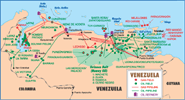|
Aug.
2001 Vol. 222 No. 8
International Outlook
|
SOUTH AMERICA
Good prospects and terms lure foreign firms
Despite worsening guerilla violence in the north and the "Argentine
flu" spreading in the south, a spate of E&P contracts has been signed.
Stuart Wilkinson, Contributing Editor
Venezuela
The country’s GDP grew 3.5% in first-quarter 2001,
versus 1% growth a year earlier. The IMF foresees 4% growth in 2001. Private activity rose 4.2%, while oil
industry activity rose 2.9%. State firm PDVSA had a record year in 2000 – net profit was up a remarkable
206%, to $7.35 billion.
President Hugo Chavez reshuffled PDVSA’s executive
board, increasing its size to seven from five members, including three retired army generals. New faces are
Jorge Kamkoff, Karl Mazeika, Vincenzo Paglione, Eduardo Praselj and retired general Juan Torres. Kamkoff,
Mazeika, Paglione and Praselj are PDVSA vice presidents.
Energy Minister Alvaro Silva has presented a final
draft of the new Hydrocarbons Law to President Chavez. Once it is approved and implemented, it will replace
the Hydrocarbons Law of 1943 and the Nationalization Oil Industry Law of 1975.
Exploration. PDVSA has begun an ambitious gas
development plan. Unfortunately, the first non-associated gas tender for 35-year licenses was only a mild
success. Of 11 blocks offered, six received bids on June 29, 2001. The TRIO consortium (TotalFinaElf,
Repsol-YPF, Otepi and Inelectra) won the most important areas, the Yucal North and South Blocks. They contain
Yucal Placer field, where reserves may total 2 to 3 Tcf of gas, and some infrastructure is already in place.
The TRIO group will invest $380 million, to produce 300 MMcfgd. Other winners include Repsol-YPF, Barrancas
Block; Pluspetrol, Barbacoas and Tiznado Blocks; and Pérez Companc, Tinaco Block.
Venezuela’s Inelectra discovered oil near Trinidad
& Tobago’s maritime border. Punta Sur 1X encountered four pay zones, two of which tested at a
combined rate of 3,000 bopd. Repsol-YPF also had good luck with its TAG 14 appraisal on the Quiamare-La Ceiba
lease, testing 21,000 bopd.
Drilling / development. PDVSA said that
drilling rose 51% in 2000, but a 22% decline is expected this year. This October, PDVSA will begin drilling
the first of 10 wells planned for the Delta platform in the Atlantic Ocean. The firm will spend $250 million
over three years on the project to gauge the quantity of gas reserves present.
Late in 2000, Statoil approved $1 billion for
Venezuelan projects through 2002, two-thirds of which were slated for Sincor (see Orinoco details). In
January, Benton launched a comprehensive technical review of its South Monagas Unit, to optimize developed and
underdeveloped reserves.
TotalFinaElf began injecting gas on Jusepin and has
seen output surpass its 2001 target of 36,000 bopd. Cotoperi field is now ready for full-scale development
with drilling expected by year-end, but geological conditions are complex.
PDVSA Gas and Repsol-YPF signed a gas production deal
for Quiriquire field. A $120-million investment will allow the drilling of 11 new wells and repairing of 15,
so that production rises to 270 MMcfgd from 170 MMcfd. The agreement extends to 2013, and the tax rate will be
fixed at 34%, rather than the previous 67.7%. A gas pipeline will be constructed from the field to the
secondary recovery plant at Jusepín.
Production. Oil output was up slightly last
year, at 3.03 million bpd, including 50,000 bcpd. PDVSA estimates that 2001’s figure will be 3.3 million
bopd.
In April 2001, PDVSA ordered private companies
operating in 19 oil fields to reduce their combined output by 30,000 bopd. This accommodates OPEC’s 9.4%
production cut for Venezuela. It is the first time since 1997 – when operating agreements were signed –
that cuts were mandated. Output from these fields is 200,000 bopd. Venezuelan production
capacity at the end of 2000 was 3.582 million bopd, 16% of which comes from operating agreements.
However, the country’s OPEC quota was 2.768 million bopd.
Meanwhile, French firm Perenco acquired 90% of Ambrosio
oil field in Lake Maracaibo. Phillips Petroleum operated the field previously, and Perenco is producing 4,000
bopd at the site.
Orinoco heavy crude. For the first time,
Orimulsion will generate power in Venezuela. Pending final approval, Ramón Laguna power station in
Zulia State will be converted to burn the watery bitumen fuel. The Orimulsion marketing arm, Bitor, will
supply China with 4 million t for a three-year period. Bitor has also signed a 10-year contract to supply 1.5
million t/yr of Orimulsion for the first stage of a 2,250-MW power station in Singapore. First delivery is
planned for 2004.
Bitor is trying again to penetrate U.S. markets –
presentations were made in Pennsylvania, North Carolina and Connecticut. Talks are also underway with Italy’s
Enel to supply 2,700 t/yr. Last year, Bitor exported 6.235 million t of Orimulsion, a 28% increase from 1999’s
level.
Conoco (51.1%) and PDVSA’s (49.9%) Zuata III
project needs $1.16 billion in investments next year and requires $2.7 billion over three years. Tax will be
paid at the 34% rate. Production of the extra-heavy crude will begin in mid-2003.
The Sincor consortium (PDVSA, 38%; TotalFinaElf, 47%;
and Statoil, 15%) shipped its first load of diluted Orinoco crude – 600,000 bbl were sent to the U.S. The
group also inaugurated an upgrader plant – part of a $4-billion investment to transform 8.5°-API
crude to 32°-API synthetic, sweet light crude.
Currently, Sincor produces 40,000 bpd of Zuata-16
crude, a mixture of heavy and 30°-API Mesa oils. The number of wells in the project has increased to 240
from 170. Meanwhile, $1.1 billion has been secured for the Hamaca heavy-crude project, operated by Texaco and
two partners. 
|



